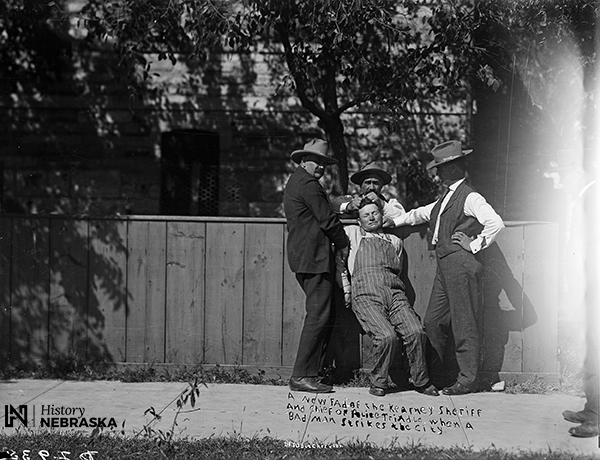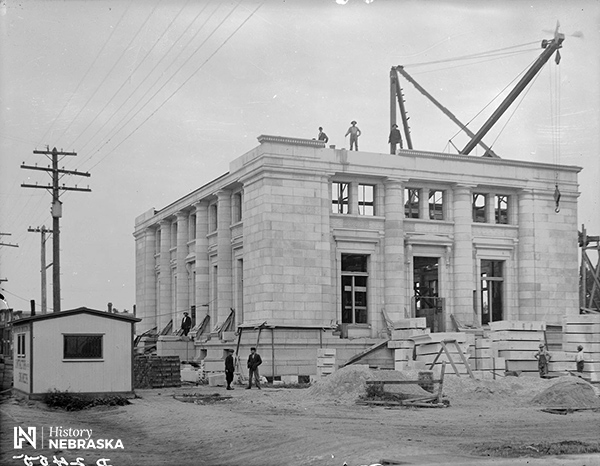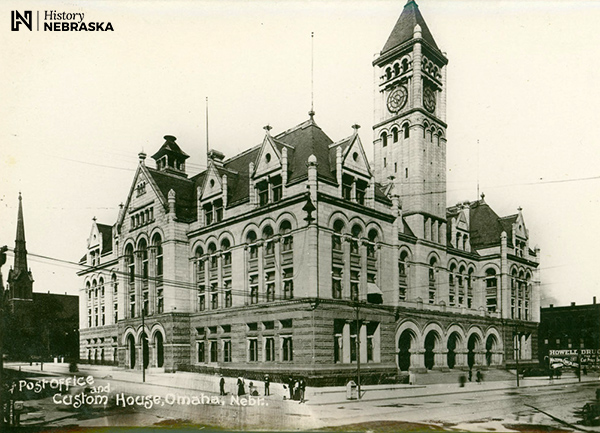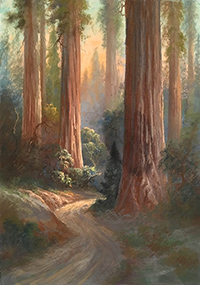Thousands of dollars are missing in Kearney, but who is the thief? Is it the trusted postal clerk, or his good friend the former sheriff? This story of betrayal includes a Christmas burglary, a sensational trial, and a Thanksgiving verdict. Happy holidays!
Thousands of dollars are missing in Kearney, but who is the thief? Is it the trusted postal clerk, or his good friend the former sheriff? This story of betrayal includes a Christmas burglary, a sensational trial, and a Thanksgiving verdict. Happy holidays!
By David L. Bristow, Editor

“A new fad of the Kearney sheriff and chief of police Trindle when a bad man strikes the city.” Photo by Solomon D. Butcher, 1905. History Nebraska RG2608-0-2935
Who is the “bad man” in this photo? Is it the man in the striped overalls? Or is he just playacting while Buffalo County sheriff Walter Sammons (right) and Kearney police chief John Trindle (left) congratulate themselves for roughing up suspicious characters?
Photographer Solomon Butcher—subject of a Nebraska History Museum exhibit through June 1, 2020—said he made this photo in 1905. Nine years later one of the men pictured here was involved in a sensational trial that shocked the community.
* * *
Walter Sammons was elected Buffalo County Sheriff in November 1905. Only 27 years old, he was already respected as a tough and fearless deputy. He was also a Nebraska National Guard officer and a Spanish-American War veteran.[1]
As a deputy Sammons not only chased criminals, but also harassed those who looked like they might be. One day he and Police Chief Trindle “picked up a couple of extremely suspicious young fellows at the Union Pacific depot,” said the Kearney Hub on April 15, 1905. In their pockets the men had some ads for companies dealing in explosives. Since “neither of them could exhibit as much as a nickel,” a local judge sentenced them to thirty days in jail for vagrancy.
It was how things were done. The photo above looks like it was taken in summer, but was probably based on similar circumstances.
* * *
Sammons spent part of Christmas Day 1913 drinking in a local bar with his buddy Delbert Smith. By then Sammons had completed three terms as sheriff, had risen to lieutenant colonel in the Guard, and was working as a claims adjustor for the Union Pacific Railroad.[2] He had a wife and five-year-old daughter at home.
Smith was a clerk at the local post office. He mentioned that the office had just received a special package containing a $5,000 bank transfer. It sat in the post office safe until the banks opened after the holiday.[3]
When the post office opened the next morning, the money was gone, a window was open, and there were footprints in the snow. Sammons quickly volunteered to help. He spent six hours a day with postal investigators, advising against the use of bloodhounds, and suggesting a half dozen local residents as suspects.[4]
* * *
Postal inspectors soon came to believe that the footprints and open window were red herrings. It looked like an inside job. Sammons then mentioned that the postmaster’s son had an arrest record, and suggested the names of other post office employees. But he didn’t mention Delbert Smith.[5]
Smith’s wife noticed that he wasn’t eating or sleeping. On January 4 he confessed to the postal inspector and other officials—but said he hadn’t acted alone.[6]
Smith said the burglary had been Sammons’ idea. Sammons asked Smith for the office key and safe combination so he could do the job himself. He said they’d split the money.
“I can fix the whole affair so no suspicion will ever be directed to you,” Sammons said, according to Smith. “I will go on the case in the morning when the theft is discovered, and I can keep the government men from suspecting you. I am just as smart as those men….”[7]
Sammons was arrested later that day, but was Smith telling the truth?
“No two young men in the county have stood higher in the esteem of as many people,” said the Kearney Hub. [8]
But the paper noted that even before even before the confession “the clues had already begun to point” toward Sammons and Smith. Postal inspectors believed Smith “fell a victim to a holiday drink and the suggestions of a supposed friend.”[9]

Kearney Post Office under construction in 1907. Today the building is home to the Museum of Nebraska Art and is listed on the National Register of Historic Places. Photo by Solomon D. Butcher. History Nebraska RG2608-0-2455
* * *
But Sammons didn’t get roughed up and run out of town. It took the better part of a year for his case to come to trial in federal court in Omaha. Out on bond, he assembled a powerful legal team led by a former US senator and assisted by two judges.[10]
By the time jury selection began on November 16, more than 40 witnesses had arrived for the prosecution and defense. With families, reporters, and friends present, it looked like half of Kearney was filling downtown Omaha streets, cafes, theaters, and hotels.[11]
Delbert Smith told his story from the witness stand. Sammons’ team said Smith stole the money himself, but multiple witnesses vouched for Smith’s whereabouts on the night of the burglary. And the footprints in the snow were too small to have been made by Smith but not by Sammons.[12] Other witnesses cast doubt on Sammons’ alibi.
But Sammons himself remained cool and collected. He took the stand and testified that he had confronted Smith after the arrests:
“I told him I had come to appeal to all that was good and manly in him to exonerate me by telling the truth. Smith began crying and his whole frame was convulsed with sobs. He cried, ‘Don’t! Don’t! I cannot talk to you when you speak to me that way.’ … ‘They made me tell that story and I’m afraid to change it now for fear they’ll hang me…”[13]
Who would the jury believe? Both men had their stories, and the money was still missing.
But the trial started going badly for Sammons. One witness said he’d overheard Sammons telling his brother that he didn’t think Smith “would squeal on me.”[14] Then it came out that Sammons’ team had paid at least one witness, a man who hadn’t even been in Kearney at the time of the burglary. Another defense witness was confronted with his own criminal record, denied it under oath, and wound up facing perjury charges. Sammons was even accused of jury tampering.[15]

Sammons’ trial was held in the Omaha Post Office, which doubled as a federal courthouse and office building. Built in 1898, the landmark building at 16th and Dodge was demolished in 1966. History Nebraska RG3348-6-388
* * *
The ten-day trial ended on Thanksgiving morning.
“I feel pretty good,” Sammons said as he arrived to hear the verdict. The jury had deliberated only a few hours and Sammons believed that meant acquittal.
But he turned pale and gripped the edges of a table when the verdict of “guilty” was read.[16]
Smith had already pleaded guilty and said he was anxious to atone for his part of the robbery. Most Kearneyites believed his story. Smith was sentenced to six months in jail and a $500 fine. Students at the Kearney teachers’ college offered to board with his wife to help her make a living while Smith was in prison.
No such offer was made for Sammons.[17]
Sammons’ request for a new trial was denied.[18] Thanks to his status and connections, he had been granted every presumption of innocence, along with the sort of legal representation that ordinary defendants could only dream of. Unlike the poor drifters he used to harrass, he didn’t look like a “bad man.” He apparently thought it would be easy to pin the crime on one of his less worthy neighbors.
Instead, the former sheriff was sentenced to two-and-half years in the federal penitentiary in Leavenworth, Kansas. He died in California in 1942.[19]
The Sammons case has an ironic postscript. Look at this painting from the collections of the Museum of Nebraska Art. Why would MONA have an obviously non-Nebraska redwood forest scene?

It was painted by Carl Sammons (1883-1968), a Kearney native who became a successful landscape artist in California. Carl might not appreciate the irony, but his painting is housed in the same building that his brother burglarized in 1913.
[1] J. Sterling Morton, Illustrated History of Nebraska, Vol. III (1913), 578.
[2] “Major Paul is Colonel,” Omaha Sunday Bee, Jan. 21, 1912; “Slow Progress in Sammons Trial,” Kearney Hub, Nov. 23, 1914.
[3] “Smith Tells His Part in Robbery, On Stand,” Omaha Evening World-Herald (hereafter, OEWH), Nov. 17, 1914.
[4] “Sammons Was Against Use of Bloodhounds,” OEWH, Nov. 19, 1914; “Sammons Suggested Names of Suspects,” Omaha Morning World-Herald (hereafter, OMWH), Nov. 21, 1914.
[5] “Smith Bothered With Conscience, Confessed Crime,” OMWH, Nov. 18, 1914; “Sammons Was Against Use of Bloodhounds,” OEWH, Nov. 19, 1914.
[6] “Smith’s Wife Tells of Husband’s Moves,” OEWH, Nov. 20, 1914.
[7] “Smith Tells His Part in Robbery, On Stand,” Omaha Evening World-Herald (hereafter, OEWH), Nov. 17, 1914.
[8] “Two Arrests for Robbery at the P.O.,” Kearney Hub, Jan. 5, 1914.
[9] “Two Arrests for Robbery at the P.O.,” Kearney Hub, Jan. 5, 1914.
[10] “Jury is Secured in Sammons Trial,” Kearney Hub, Nov. 17, 1914.
[11] “Smith Examination Unfinished Tuesday,” Kearney Hub, Nov. 18, 1914.
[12] “Testimony Narrows to Story of Smith,” Kearney Hub, Nov. 19, 1914; “Dramatic Diversion in Court Thursday,” Kearney Hub, Nov. 20, 1914; “Smith’s Testimony Strongly Supported,” Kearney Hub, Nov. 21, 1914; “Sammons Seeks to Prove Alibi,” Kearney Hub, Nov. 24, 1914.
[13] “Sammons Tells His Story on the Witness Stand,” OMWH, Nov. 25, 1914.
[14] “Sammons Seeks to Prove an Alibi,” Kearney Hub, Nov. 24, 14.
[15] “Paid by Defense to ‘Skirmish Around’,” OEWH, Nov. 23, 1914; “Sammons Tells His Story on the Witness Stand,” OMWH, Nov. 25, 1914; “Commissioner Cleary Holds Dr. Tupper Kirby,” OMWH, Dec. 11, 1914; “Smith’s Wife Tells of Husband’s Moves,” OEWH, Nov. 20, 1914.
[16] “Sammons Guilty of the Theft of $5,000,” OMWH, Nov. 27, 1914.
[17] “The Jury Finds Sammons Guilty of Robbing Safe,” Kearney Hub, Nov. 27, 1914; “Both Sammons and Smith Sentenced,” Kearney Hub, Dec. 22, 1914.
[18] “Sammons is Denied Reopening of Case,” Omaha Sunday World-Herald, Dec. 13, 1914.
[19] “Attorneys Ask New Trial for Sammons,” OEWH, Dec. 12, 1914; “Sammons is Denied Reopening of Case,” Omaha Sunday World-Herald, Dec. 13, 1914; “Both Sammons and Smith Sentenced,” Kearney Hub, Dec. 22, 1914; “Walter Franklin Sammons, 1878-1942,” MyHeritage, https://www.myheritage.com/names/walter_sammons, accessed July 18, 2019.



